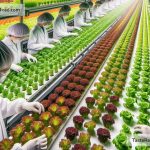Unveiling the Magic of Carbon-Farming Ingredients: A Simple Guide
In today’s world, where climate change is a pressing issue, it’s essential to explore innovative methods to safeguard our planet. One such revolutionary approach is carbon farming, a concept that’s rapidly gaining momentum for its potential to combat climate challenges while supporting agricultural productivity. This blog post dives into the fascinating world of carbon-farming ingredients, shedding light on what they are, how they work, and why they could be a game-changer for the environment.
What is Carbon Farming?
Before we explore the ingredients, let’s understand carbon farming. In simple terms, carbon farming involves agricultural practices aimed at capturing carbon dioxide (CO2) from the atmosphere and storing it in plants and soil. It’s like giving the earth a helping hand to soak up excess carbon, which is a significant contributor to global warming.
The Role of Carbon-Farming Ingredients
Carbon-farming ingredients are essentially the crops and plants cultivated through carbon farming techniques. These ingredients are not just any crops; they are specifically selected for their superior ability to absorb and store carbon. By integrating these ingredients into the food supply, we can potentially reduce the carbon footprint of our diets and contribute to a healthier planet. Let’s delve into some of these powerful ingredients and their benefits.
1. Trees and Perennials
Trees and perennial plants are the superheroes of the carbon farming world. Their deep root systems allow them to absorb significant amounts of carbon from the atmosphere, storing it in their biomass and the soil. By incorporating fruit and nut trees, along with perennial vegetables and herbs into farming systems, we not only capture carbon but also provide nutritious ingredients for our tables.
2. Cover Crops
Cover crops like clover, vetch, and rye are planted during off-season times when the soil would otherwise be bare. These plants act as a blanket, protecting the soil from erosion while capturing carbon. They also enrich the soil, making it more fertile for the next round of crops. Incorporating the biomass from these cover crops back into the soil can improve its health and carbon storage capacity.
3. Agroforestry Products
Agroforestry, the practice of mixing crops with trees, provides a variety of carbon-farming ingredients. From cocoa and coffee grown beneath the canopy of taller trees to the nuts and fruits harvested from these mixed systems, agroforestry ingredients carry the promise of reduced carbon footprints. They also promote biodiversity, offering a habitat for wildlife.
4. Grass-fed Livestock
While livestock farming is often criticized for its environmental impact, grass-fed systems present a different story. When animals graze on grass, they stimulate the plants to grow deeper roots, which helps in more carbon absorption. The key here is responsible grazing management that ensures the grasslands can regenerate, making grass-fed meat and dairy products carbon-farming-friendly ingredients.
Why Embrace Carbon-Farming Ingredients?
The potential benefits of embracing carbon-farming ingredients are vast. First and foremost, they offer a path towards mitigating climate change by reducing atmospheric CO2 levels. But the advantages don’t stop there. These practices improve soil health, enhancing water retention and resistance to erosion, which in return increases the resilience of our food systems against climate extremes like droughts and floods.
Moreover, carbon farming fosters biodiversity and helps in preserving wildlife habitats, creating a healthier ecosystem. For consumers, choosing products made from carbon-farming ingredients can be a direct way to contribute to environmental conservation efforts, aligning their purchasing decisions with their values.
How Can You Support Carbon Farming?
Supporting carbon farming can be as easy as making mindful consumer choices. Look for products that are labeled as coming from regenerative or carbon farming practices. Support local farmers who implement these techniques by buying their produce. You can also advocate for policies that incentivize carbon farming and raise awareness about its benefits.
The Future is Green
The exploration of carbon-farming ingredients is not just a journey towards more sustainable agriculture; it’s a step towards a healthier planet and future. As we become more conscious of our environmental impact, adopting practices that support carbon sequestration will be crucial. By choosing carbon-farming ingredients, we can all play a role in this transformative movement, ensuring a greener, more resilient world for generations to come.
In the battle against climate change, every action counts. Embracing carbon-farming ingredients offers us a chance to make a positive impact, one meal at a time. Let’s nurture our planet by supporting agricultural practices that restore rather than deplete. The potential of carbon-farming ingredients is immense, and together, we can unlock it for a brighter, sustainable future.


